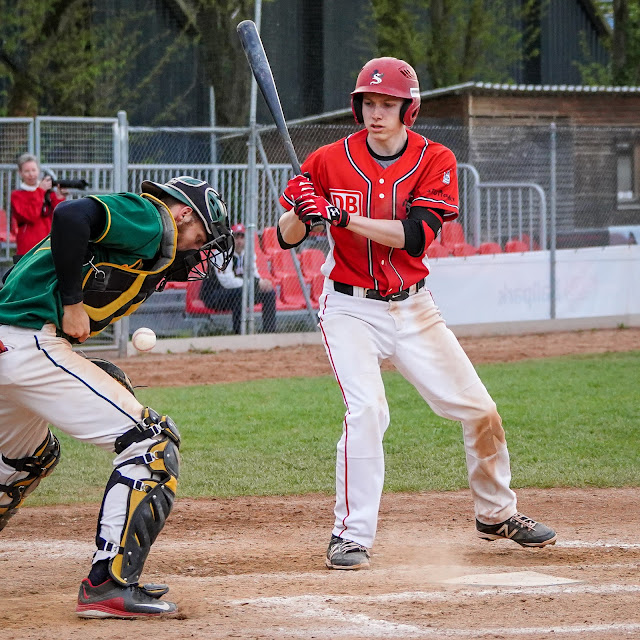I've already talked about using the silent shutter for concerts and the caution one must exercise with moving objects or while panning. Here is another good example of when to be careful when choosing the silent shutter.
Yesterday I was standing in the visiting team's bullpen shooting pictures into the glorious afternoon light. I had a great view of the right-handed batters and the infield. I didn't want the players to be distracted by my shooting, so I went silent most of the time.
As you can see in the two photos above, I was panning with the runner, which resulted in everything behind him being slanted in the direction the lens was panning, if the person or object was either not moving, moving slowly or not at all. The first picture has lots of vertical lines which call attention to themselves in a case like this. The second one isn't so bad.
The one below, in contrast, was also taken with the silent electronic shutter, but the ball is moving so slowly that it still appears round and the fielder in red has normal proportions. Using the silent shutter still has two main advantages: it draws less attention to your camera and yourself at a game like this and it doesn't wear down your shutter mechanism.
The light dwindled as the second game continued. I started shooting at 4 pm at around 800 ISO so that I could get some fast shutter speeds (between 1/500 and 1/2,000). I was using the Sony G f4.5-5.6/70-300 at around 200mm most of the time, but this is a lens I like to used stopped down a bit, so I needed the extra ISO. No problem for this camera.
 |
| The Hornet's catcher gets hit by a deflected pitch in the right wrist. He moved out to left field to give his injury time to heal. |
Sometimes I switched to APS-C mode for a 1.5x magnification with the touch of a button (more on my preferred settings in the next blog post). I did this mainly because I knew I would neither need nor want huge files; 10MP would be enough. In addition, the files can be saved to the memory card much more quickly this way, not that I had a problem with buffering - I simply didn't take that many in one burst.
I also took the first JPEGs with High ISO Noise Reduction set to "Low" and then the others at "Normal", but didn't notice any difference between the two. Most of the best pictures were taken at around 1/1,000 sec and 1,000 ISO. The aperture stayed at around 5.6-6.3 most of the time, though I did pump it up to 7.1 when I didn't need the extra speed.
 |
| This was taken at 250mm x1.5 magnification using the APS-C area of the sensor. |
The last thing I played with during the game was the video function, thinking I'd take some frame captures of the action. It just so happens that I got some footage of some of the most exciting parts of the game. Below, you see the opposing pitcher getting hit by the ball. Then he took off for first base but stopped when he saw the ball being thrown home to tag out a runner. The catcher missed the throw but then got the second runner out. A real bit of excitement in what many Germans consider an incomprehensible and boring game! I thought the whole thing was thrilling. There were a lot of hits, good pitching and even an incident of "catcher interference", which I had never heard of!
Below: A slide into home plate captured on video, made into a print with Lightroom. The camera also has a function for doing this. Here is the difference in quality between the two processes:
That's right; no difference. Here is the original 4K video. Enjoy!






































